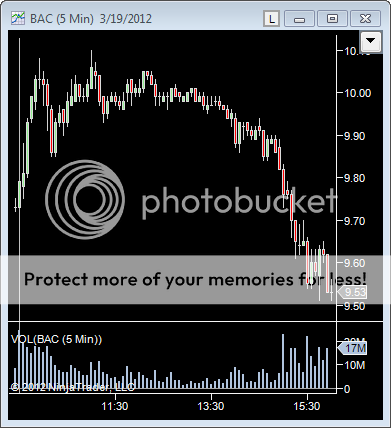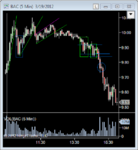I find this very interesting DT. Obviously the question of HFT will rumble on for some time, but meanwhile what can we do?
Assume that chart is total bullsh1t, full of trades that basically shouldn’t have happened. Nonetheless, all I see is a great chart that threw up several excellent trades just using very basic price action. This to me looks like an extraordinarily easy day to trade - the price action is exceptionally smooth and regular. I have a suspicion that whatever effect HFT has (and I personally think overall it is small, although that’s just my opinion and may well be wrong), it is likely to be at worst neutral and at best beneficial for retail punters.
Anyway, the chart (see attachment at bottom below quoted chart). I’m sure this will all be old hat to you and I know you’re not a big chart fan, but newer traders reading this thread might find it useful.
The day opened very strongly and after a little initial hesitation moved up hard in what I would describe as effectively a spike – the slope of the trend line (first green line) suggests unsustainable behaviour to me. I would be looking for a pullback to get in long.
When the pullback came, it was in the form of a bear spike. I would not be looking to sell on the first bearish action after such a strong bull spike, but the strength of the bear spike would make me wary of buying also. The bear spike was getting stronger and more urgent as it progressed, and this again would make me think it was unsustainable. Whenever I see this I always think whether we are looking at a vacuum as buyers step aside rather than genuine heavy selling. We then got a miniature double bottom and a strong bull reversal bar (inside the blue rectangle) and this coupled with the earlier solid bull strength makes for a good spike / pullback continuation above the large bullish bar (you could think of it as a reversal as well of course of the small bear trend, but to me this is a with-trend continuation trade – not that it really matters what label you put on it). There is a good chance that such a strong bull move won't fail on the first attempt, and it is reasonable to expect some kind of test of the extreme. One thing I would note at this stage is that bears have now put in a strong showing (albeit an unsuccessful one for now).
So that’s one good and I think very obvious trade.
Price then resumes up in a tight channel – an opening trend resumption. I would note that the slope of the trend line (second green line) this time is much shallower than the first one. The bullish pressure in the market might be weakening. This channel ends in a double top with the previous high. Price strongly rejects this area for a second time. Context is all important - the first time I would be thinking absence of buyers, but the second time we get a strong reaction one starts to think in terms of the presence of sellers.
It then moves up in a bullish channel, which I would now be wondering about, as it might be a bear flag. I would note that the new trend line is shallower still (third green line), and I would now be seriously thinking in terms of a transition to a trading range at least or even possible reversal of the day’s trend thus far.
There is a reasonable break out below the channel and this would be a reasonable if aggressive entry based on the prior and mounting bear strength. I personally would not have taken it, but I think nonetheless it is a perfectly sound entry. Note that after the test of the bullish extreme, we have now seen a lower high.
Price then settles into its middle of the day doldrums with a tight trading range, which naturally makes one think “breakout mode”. We get a reasonable bear breakout (just on the edge of the first green box) and I think selling below that bear bar would be reasonable, albeit too aggressive for me. However, we immediately get a weak bull reversal bar with a “pin bar” shape. I love pin bars because they are so often great fade set ups (LOL), and this I think would be a very solid entry below it (sell below first blue line). Obviously, there are going to be new sellers below, and there are also going to be disappointed longs who are going to get out once price breaks down.
So I would say this is the second very solid (but perhaps not so obvious for new punters) trade of the day.
We get a strong bearish bar followed by a strong bullish bar (first green box). I would not be looking to go long at this stage, although some might given the double bottom with the earlier pullback (blue box from early in the day); a long wouldn’t have triggered however. I might have had a sell under the bullish bar, reasoning as above that we would have all sorts of sell orders under there.
I would say that was the third very sound trade of the day.
Now it gets very easy. The bull reversal peters out and price breaks down strongly once again. You could have sold the breakout of the bear flag (although I wouldn’t). Bulls step in once again with a reasonably strong showing (second green box). This is the second attempt to reverse the mounting bearishness and if this one fails (so quickly after the previous attempt failed) it is likely that we will see a good move down as bulls will likely step aside for lower prices. There could easily be a lot of bulls trapped here.
The fourth trade (and the trade of the day) was a sell under that bullish bar (second green box, sell under the third blue line), because you are going to have a lot of trapped bulls forced out at that stage. Sure enough, price breaks out strong and plummets. Note as well this is a break of a triple bottom, which is a solid place to look to sell. Bulls have very likely lost the day, and many will step aside until we’ve had a good move down.
The market looks strongly like it has flipped to bearish now, and the little pause (blue circle) looks to me like a great place to push your shorts. Again, there are early bulls in that area who are likely to be disappointed and will sell below the big bearish bar with lower tail on the right hand edge of the circle. Personally in situations like this I sell below the bear inside doji, but a more cautious trader could wait for the downside break of the big bearish bar. Bulls from earlier in the day who need to finish flat will be bailing now, adding to the selling pressure as we move towards the close (one of the reasons why days like this - strong one way, but no follow through and then reverse) can be so profitable as you get the late stampede for the exits).
So I make that 5 very sound trades just using very basic price action on one chart, thinking about the market context and crucially considering where orders are likely to be (particularly those exit orders placed by trapped traders). I’m sure a competent person could find more to do using the ladder, although I personally don't find it useful for some of the reasons already discussed (but mostly because it gives me too much to process and ends up being a distraction for me). I’m not saying I’d have taken all of them, but even just hitting the daisy (trade 4, final bull capitulation) would give you an awesome day.
As I say, this is just very basic analysis. As I’m sure you know, there is a lot more on this chart, but I just wanted to highlight some of the most obvious points that even a fairly new trader could, with some thought and a little experience, easily pick out and trade in real time. The key here is to continually consider the market context, most particularly the true trend. Many inexperienced traders would think we were still in bullish mode, but the bigger picture combined with a few small examples of price action (namely the repeated failure of apparently solid-looking bull moves) showed the true developing trend long before it was fairly under way. Then it's just a matter of fading the weak counter-trend moves (that weak hands would mistakenly view as with-trend or resumption moves).
The way I manage things it would be:
Trade 1 – scratch.
Trade 2 – Profit.
Trade 3 – Profit and pretty easy management.
Trade 4 – Profit and very easy management.
Trade 5 – Profit and very easy management.
The main point is, all this action may be crap generated by HFT firms, but who cares? They created a very easy – and profitable – day to trade.
I had a look at the volume on stocks yesterday.
It used to be that C was getting seriously hit by HFTs. They moved away when C did a reverse split.
Looking at the markets, it seems that BAC is volume leader:
680 million shares traded and a 50c range. One of those 5 min bars had 17M traded and a 12c range. It's certainly not the same as C was a few years ago but this looks like algo rebate trading to me. It's not mean revision and it's certainly not directional. If I'm paying for these monkeys to get rebates on those trades, I'm not happy...
🙂





